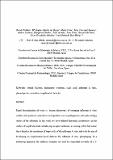Por favor, use este identificador para citar o enlazar a este item:
http://hdl.handle.net/10261/93656COMPARTIR / EXPORTAR:
 SHARE SHARE
 CORE
BASE CORE
BASE
|
|
| Visualizar otros formatos: MARC | Dublin Core | RDF | ORE | MODS | METS | DIDL | DATACITE | |

| Título: | Biomimetic architectures for the impedimetric discrimination of influenza virus phenotypes |
Autor: | Wicklein, Bernd CSIC ORCID ; Martín del Burgo, M. Ángeles; Yuste, Miriam CSIC; Carregal-Romero, Ester; Llobera, Andreu CSIC ORCID; Darder, Margarita CSIC ORCID; Aranda, Pilar CSIC ORCID ; Ortín, Juan CSIC ORCID; Real, Gustavo del; Fernández Sánchez, César CSIC ORCID ; Ruiz-Hitzky, Eduardo CSIC ORCID | Palabras clave: | Influenza A virus Hybrid bilayers Impedimetric detectors Biomimetic receptors Phenotype discrimination |
Fecha de publicación: | 2013 | Editor: | Wiley-VCH | Citación: | Advanced Functional Materials 23(2): 254-262 (2013) | Resumen: | Rapid discrimination of avian vs. human phenotypes of emerging influenza A virus isolates with pandemic potential is an important issue in pathogenesis and epidemiology studies of the infection. In this work, functional architectures are tailored on the surface of a gold electrode, introducing receptor molecules as a sensing entity that mimics those found in the membrane of target cells of the influenza A virus and with the aim of developing an impedimetric-based detector for influenza A virus phenotyping. In a bottom-up approach, the artificial receptors are built by sequential assembly of a 1-octanethiol/octyl- galactoside hybrid bilayer, followed by an enzyme-mediated functionalization of the terminal galactoside groups with sialic acid molecules. The detection mechanism relies hence on the specific affinity between the sialic acid-galactose receptor moieties anchored on the modified electrode surface and the hemagglutinin (HA) viral surface protein. By using the appropriate type of sialyltransferase enzyme, sialylation of galactose residues is made through α-2,3 or α-2,6 linkages. This permits the envisaged impedimetric detector to discriminate rapidly between avian vs. human strains of influenza A virus with the absence of elaborate sample preparation steps. In contrast to immunosensors based on antibodies as bioreceptor, the sialylated modified gold electrode is also able to distinguish among influenza phenotypes, which could make the here presented detector a reagentless, label-free diagnostic device for influenza phenotyping. Biomimetic architectures for the impedimetric discrimination of influenza virus phenotypes are tailored by a self-assembly process on gold substrates. Incorporated sialic acid molecules as sensing entities mimic receptors found on target cells of the influenza A virus. The resulting detector rapidly discriminates between avian and human strains of influenza A virus, acting as a reagentless, label-free diagnostic device for influenza phenotyping, which is important in surveillance and prediction of pandemics. Copyright © 2013 WILEY-VCH Verlag GmbH & Co. KGaA, Weinheim. | Versión del editor: | https://doi.org/10.1002/adfm.201200377 | URI: | http://hdl.handle.net/10261/93656 | DOI: | 10.1002/adfm.201200377 | Identificadores: | doi: 10.1002/adfm.201200377 issn: 1616-301X e-issn: 1616-3028 |
| Aparece en las colecciones: | (IMB-CNM) Artículos (ICMM) Artículos (CNB) Artículos (INIA) Artículos |
Ficheros en este ítem:
| Fichero | Descripción | Tamaño | Formato | |
|---|---|---|---|---|
| Wicklein et al_Biomimetic_AFM_Postprint.pdf | Artículo principal-Vs Postprint | 1,07 MB | Adobe PDF |  Visualizar/Abrir |
CORE Recommender
SCOPUSTM
Citations
28
checked on 16-abr-2024
WEB OF SCIENCETM
Citations
22
checked on 19-feb-2024
Page view(s)
403
checked on 19-abr-2024
Download(s)
1
checked on 19-abr-2024
Google ScholarTM
Check
Altmetric
Altmetric
NOTA: Los ítems de Digital.CSIC están protegidos por copyright, con todos los derechos reservados, a menos que se indique lo contrario.
